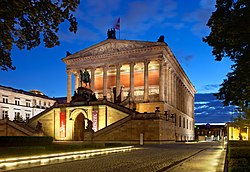Alte Nationalgalerie
The gallery was built from 1862 to 1876 by the order of King Frederick William IV of Prussia according to plans by Friedrich August Stüler and Johann Heinrich Strack in Neoclassical and Renaissance Revival styles.
The current building, shaped like a Roman temple with an appended apse, was designed by Friedrich August Stüler and after his death, realised in detail under Carl Busse.
Friedrich August Stüler began working on a design for the building in 1863, based on a sketch by King Frederick William IV of Prussia.
In 1866, by order of the king and his cabinet, the Kommission für den Bau der Nationalgalerie (Commission for the construction of the national gallery) was created.
In 1896 he was succeeded by Hugo von Tschudi, who acquired Impressionist works, risking conflict with the Kaiser because this ended the collection's focus on German art.
The three-year, $62 million renovation of the Alte Nationalgalerie was part of a refurbishment of Museum Island and the energetic effort by government and private institutions to re-establish Berlin as Germany's political and cultural heart.
The building was designed by Friedrich August Stüler with details by Carl Busse, in an architectural style that is a mix between late Classicism and early Neo-Renaissance, and realised by Heinrich Strack.
It was intended to express "the unity of art, nation, and history", and therefore has aspects reminiscent of a church (an apse) and a theatre (the grand staircase) as well as a temple.
[7] The collection contains works of the Neoclassical and Romantic movements (by artists such as Caspar David Friedrich, Karl Friedrich Schinkel, and Karl Blechen), of the Biedermeier, French Impressionism (such as Édouard Manet and Claude Monet) and early Modernism (including Adolph von Menzel, Max Liebermann and Lovis Corinth).
Among the most important exhibits are Friedrich's Der Mönch am Meer (The Monk by the Sea), von Menzel's Eisenwalzwerk (The Iron Rolling Mill) and sculptor Johann Gottfried Schadow's Prinzessinnengruppe, a double statue of princesses Louise of Mecklenburg-Strelitz and Frederica of Prussia.

